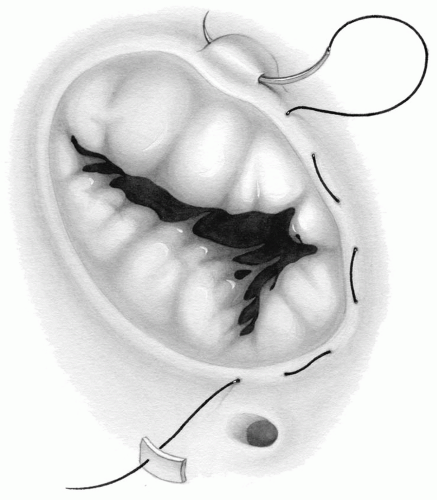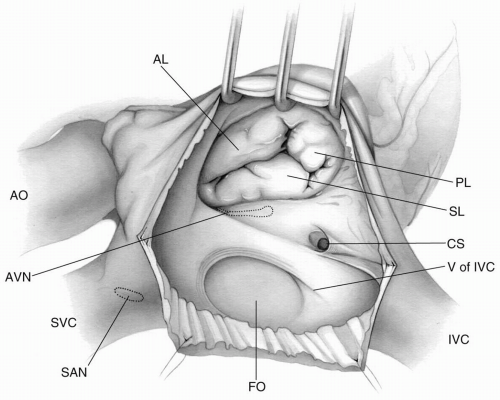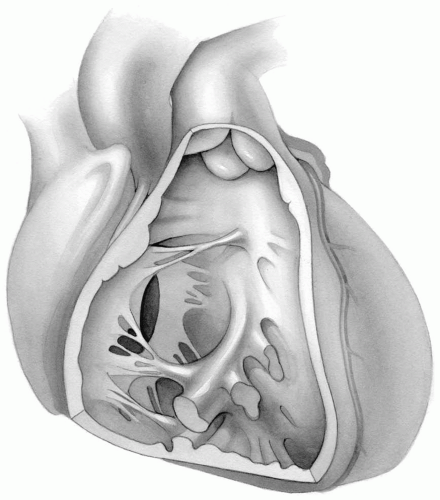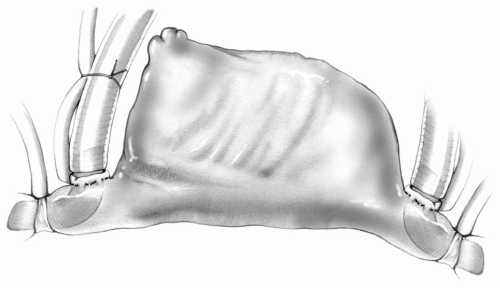Surgery of the Tricuspid Valve
The most common indication for surgical intervention on the tricuspid valve is functional tricuspid regurgitation. Functional or secondary tricuspid insufficiency occurs frequently in patients with advanced mitral valve disease and pulmonary hypertension. The insufficiency may disappear or improve significantly when successful mitral valve repair or replacement is accomplished. The current approach is to be more aggressive with secondary tricuspid disease, and to perform an annuloplasty in patients with dilated annuli or more than mild tricuspid insufficiency.
Rheumatic fever continues to be the most common cause of organic tricuspid valve disease. With rare exceptions, it is associated with mitral and, in many patients, aortic valve disease as well. Usually both stenosis and insufficiency are present. Degenerative tricuspid valve disease is less common, but severe tricuspid regurgitation can result requiring surgical repair. Tricuspid valve bacterial endocarditis is seen in intravenous drug abusers, occasionally in patients with long-standing central venous catheters, and infrequently in patients with small perimembranous ventricular septal defects. Often the infection destroys leaflet tissue, causing tricuspid insufficiency. Iatrogenic causes of tricuspid valve dysfunction include pacemaker lead-induced tricuspid regurgitation and radiation therapy, which may result in retracted, calcified valve leaflets. Carcinoid affects the tricuspid and frequently the pulmonic valve, causing stenosis as well as insufficiency.
Technical Considerations
Surgical Anatomy of the Tricuspid Valve and the Right Ventricle
The tricuspid valve guards the right ventricular orifice. It consists of a septal leaflet, a large anterior leaflet, and a small posterior leaflet, all three of which are attached to and continuous with the tricuspid ring. These valve leaflets are folds of endocardium strengthened by fibrous tissue. Small accessory leaflets are often present in the angles between the major leaflets. The atrioventricular node lies in the atrial septum adjacent to the septal leaflet, just anterior to the coronary sinus. Its location can be pinpointed at the apex of the triangle of Koch (which is bordered by the septal leaflet, the tendon of Todaro, and the orifice of the coronary sinus). The atrioventricular conduction bundle (bundle of His) extends from the atrioventricular node through the central fibrous body into the ventricles under the membranous part of the interventricular septum. It is approximately 2-mm thick and consists of bundles of fine muscular fibers. There is normally no muscular continuity between the atria and the ventricles except through the conducting tissue of the atrioventricular bundle, but aberrations may exist that can give rise to rhythm disturbances (Fig. 7-1).
The right ventricular cavity is tubular and triangular in contrast with that of the left ventricle, which is conical. It is bounded by concave anterior and posterior walls and a convex septal wall. There are at least three groups of papillary muscles that stem from the inner aspect of the right ventricular cavity. Chordae tendineae, which are nonelastic chords of tissue, arise from the papillary muscles and fuse to the free edges and the ventricular surfaces of the leaflets of the tricuspid valve. The chords of each papillary muscle control the contiguous margins of two cusps. Hence, chords pass from a large anterior papillary muscle to the anterior and posterior leaflets. A posterior papillary muscle, often represented by two or more components, gives rise to chords that attach to the posterior and septal leaflets. Finally, from a variable group of small septal papillary muscles, chords fan out and fasten to the anterior and septal leaflets of the tricuspid valve. A bridge of muscle, the moderator band, stems from the septum, crosses the cavity of the right ventricle to the free wall, and contributes to the origin of the anterior papillary muscle. A tract of specialized tissue associated with the conduction system runs through the moderator band (Fig. 7-2).
Incision
A median sternotomy is the preferred approach for acquired valvular disease because it offers complete exposure for exploration of the mitral, aortic, and tricuspid valves. The tricuspid valve can also be approached through a lower ministernotomy or submammary right thoracotomy (see Chapter 1).
Historically, digital palpation through a purse-string suture on the right atrial appendage was used to assess tricuspid insufficiency before the initiation of cardiopulmonary
bypass. Currently intraoperative transesophageal echocardiography is used to evaluate the tricuspid valve. Because tricuspid insufficiency is load dependent, clinical history, preoperative echocardiography and/or right heart catheterization data are useful in determining whether the tricuspid valve should be addressed. Some surgeons advocate exploring the tricuspid valve in all patients undergoing mitral valve surgery to directly measure annular size.
bypass. Currently intraoperative transesophageal echocardiography is used to evaluate the tricuspid valve. Because tricuspid insufficiency is load dependent, clinical history, preoperative echocardiography and/or right heart catheterization data are useful in determining whether the tricuspid valve should be addressed. Some surgeons advocate exploring the tricuspid valve in all patients undergoing mitral valve surgery to directly measure annular size.
Cannulation
When surgery on the tricuspid valve is contemplated, both vena cavae are cannulated directly (Fig. 7-3). A cannula is placed in the ascending aorta, and cardiopulmonary bypass is initiated.
Isolated tricuspid valve surgery can be performed on cardiopulmonary bypass with a warm, beating heart. Most of the time, repair or replacement of the tricuspid valve is performed as part of a combined procedure that includes mitral and/or aortic valve surgery with or without concomitant coronary artery bypass grafting.
At the conclusion of these other procedures, the aortic cross-clamp is removed, and deairing of the left heart is completed. The tricuspid valve is then repaired while the patient is being rewarmed.
At the conclusion of these other procedures, the aortic cross-clamp is removed, and deairing of the left heart is completed. The tricuspid valve is then repaired while the patient is being rewarmed.
Exposure of the Tricuspid Valve
A longitudinal or oblique atriotomy is made approximately 1 cm posterior to and parallel to the atrioventricular groove. The atriotomy edges are retracted with sutures, and exposure of the tricuspid valve is further facilitated by means of appropriately sized retractors.
The sinoatrial node is prone to injury during cannulation and passage of a tape around the superior vena cava. The atriotomy should be well away from the sinoatrial node, and its superior extension should be limited to approximately 1 cm from the superior margin of the right atrium.
Functional Tricuspid Regurgitation
The controversy regarding the management of functional tricuspid insufficiency reflects the difficulty of precisely distinguishing the two stages of the same disease process, that is, irreversible and reversible tricuspid valve insufficiency. Irreversible functional tricuspid insufficiency is the outcome of chronic right ventricular dilation, with a permanent increase in right ventricular volume and tricuspid annular dilation. Certainly, if severe tricuspid regurgitation is present, significant tricuspid pathology must exist which is most likely irreversible. However, even if the tricuspid insufficiency is only mild or moderate, irreversible tricuspid pathology may still be present. This is because the assessment of the degree of tricuspid regurgitation depends on right ventricular preload and afterload at the time of the study. A better marker of irreversibility may be annular size. The distance from the anteroseptal to the anteroposterior commissure is measured directly through the open right atrium. If it is 70 mm or greater (twice the normal size), the tricuspid annulus will most likely not return to normal and may very well continue to dilate.
 We recommend proceeding with tricuspid valve repair in adults anytime the annular size exceeds 70 mm or if the severity of insufficiency is moderate to severe.
We recommend proceeding with tricuspid valve repair in adults anytime the annular size exceeds 70 mm or if the severity of insufficiency is moderate to severe.Both the De Vega and ring annuloplasty techniques are satisfactory procedures for treating functional tricuspid regurgitation. Bicuspidization of the tricuspid valve can be performed quickly, and may be preferred in patients with mild to moderate insufficiency or a less dilated annulus. Some surgeons have found that placement of an annuloplasty ring results in a lower incidence of recurrent tricuspid insufficiency compared with the De Vega procedure or bicuspidization.
 Get Clinical Tree app for offline access 
|





